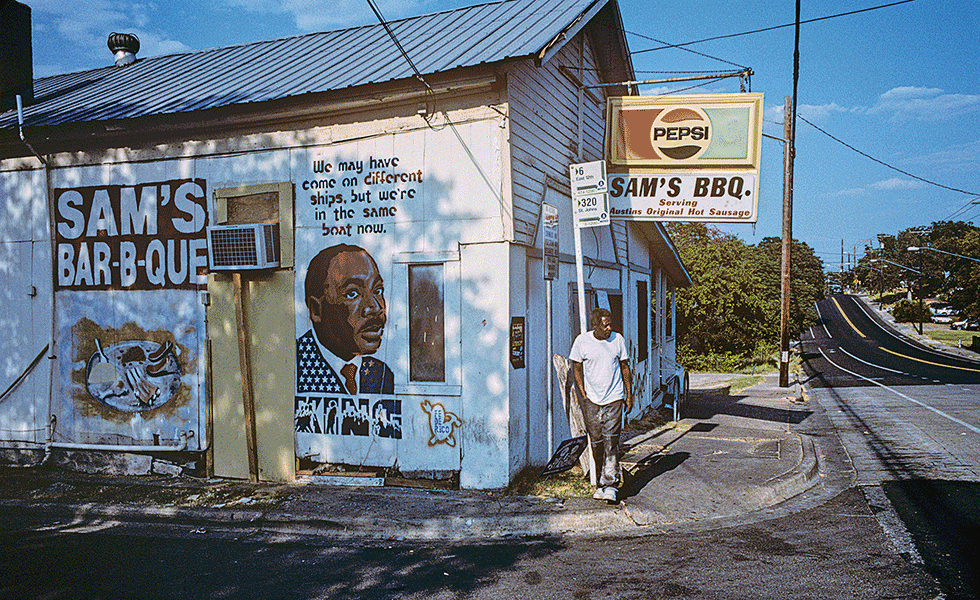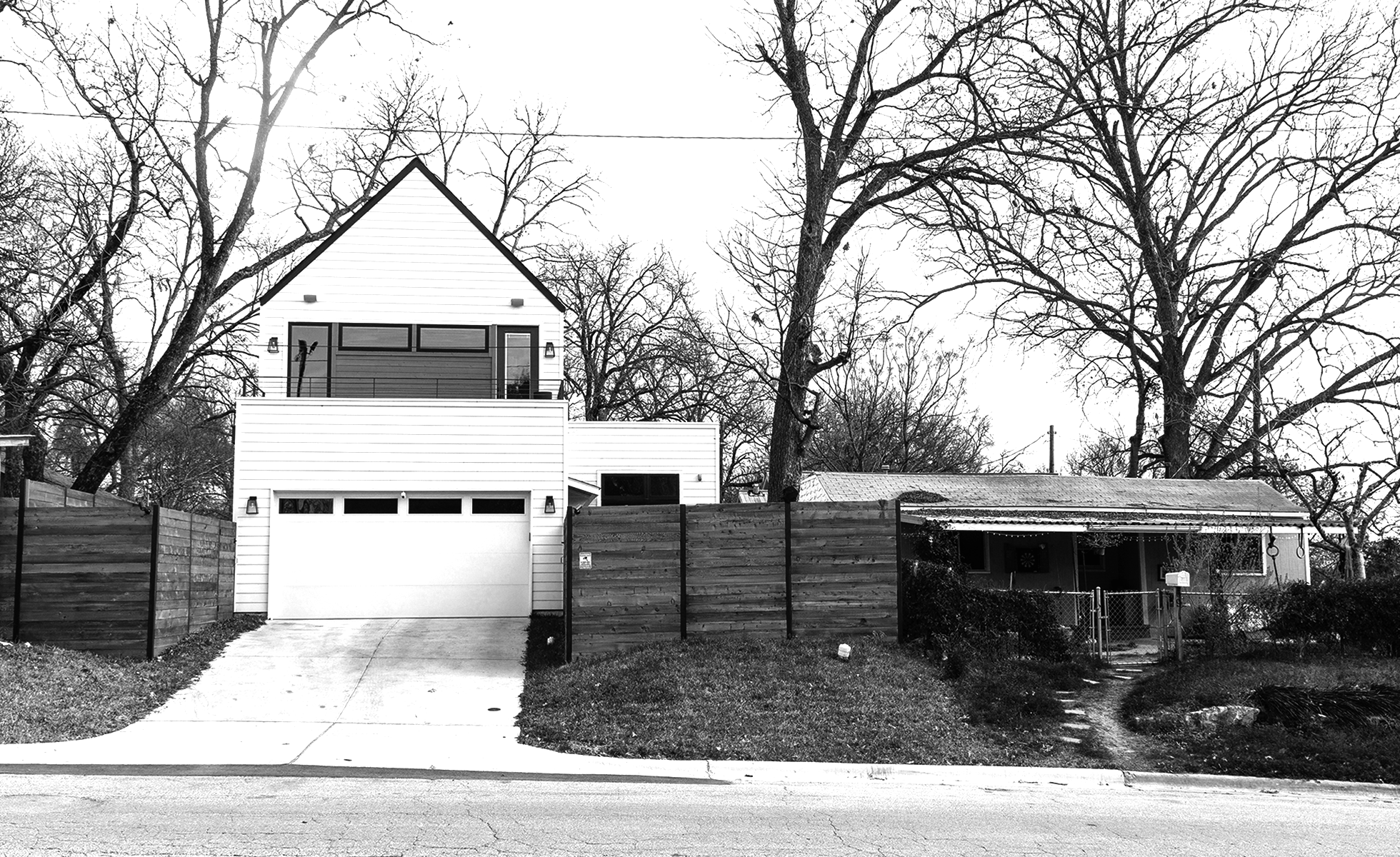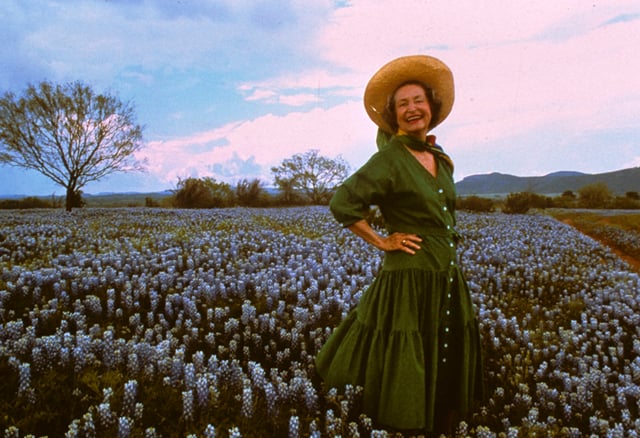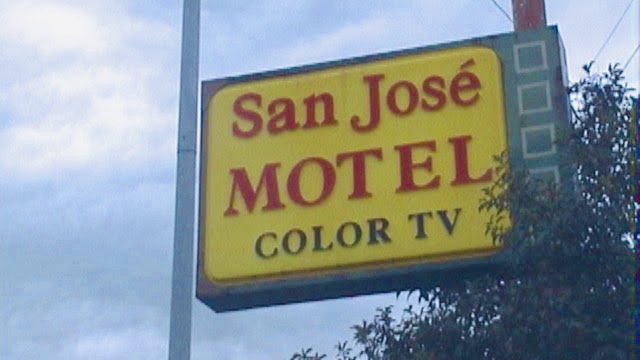
Liz Lambert’s New Film Offers a Shallow Portrayal of a Changing Austin
‘Through the Plexi-Glass’ inadvertently portrays the Austin-based hotelier as insensitive and voyeuristic.
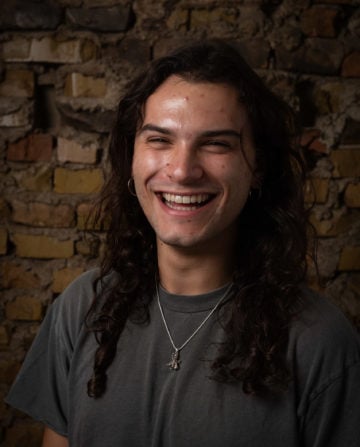
Above: The then run-down San José Motel, which Liz Lambert eventually renovated and reopened in its current form.
Liz Lambert’s new movie is a case study in why property developers shouldn’t make documentaries about gentrification. The Austin-based hotelier’s debut film, released in March, attempts to give viewers a lens into the struggles faced by business people seeking to profit off making this city hip. On that front—and on very few others—it succeeds. The film inadvertently portrays Lambert as insensitive and voyeuristic, as she dehumanizes the film’s subjects. She presents an apolitical version of “Keep Austin Weird,” one that imagines poor, homeless Austinities as “eccentrics” of the past who don’t fit into a gleaming modern city.
Austinites are probably familiar with Lambert’s name—Lambert is well known for designing stunning and high-end hotels and restaurants in the capital city and elsewhere in the state. For more than 20 years, she hosted South By San José, a sort of locals-only version of the sprawling downtown festival. Now, she’s added director and producer with Through the Plexi-Glass: The Last Days of the San José, released at the virtual SXSW this year. It chronicles the early days of her first project, the bungalow-style, upscale boutique hotel on South Congress Avenue. The film covers the three years in the late 1990s after Lambert bought the original property, then the run-down San José Motel, which she eventually renovated and reopened in its current form.
While it wasn’t spliced together until recently, Lambert shot the movie between 1995 and 1998, during which she recorded interactions with people who hung around South Congress and families who were living at the motel on the verge of homelessness. Lambert evicts them and then has the audacity to stick a camera in their faces and ask them where they’ll go next. Several say they have no idea.
In a city that has spent the last year grappling with the issues of homelessness and police violence, the film feels out of touch. It purports to start a conversation about local problems, and specifically about gentrification. The film states that the Hotel San José sparked the gentrification of South Congress, which today is a bustling, expensive tourist district that has dramatically raised the cost of living in the neighborhoods around it. But the film fails to acknowledge the much more basic fact that gentrification has its roots in racist, classist decisions, and has been deeply harmful to many people in Austin. Lambert wants us to believe that South Congress could either have remained as it was in the 1990s or transformed into the glitzy, tourist haven it is today, a false dichotomy that obscures the needs of poor communities.
Well before Lambert bought the motel, South Congress was a main artery for entering Austin proper. The construction of Interstate 35 redirected traffic from the area in the 1950s and many businesses shuttered. Over the following decades South Congress became synonymous with drugs and sex work. The San José was smack dab in the middle of a changing city. Through Lambert’s lens, we see blood-stained linens and needles left in bathroom cabinets. She films police arresting people in the parking lot on multiple occasions.
Lambert told the Observer she started recording for two reasons, out of safety concerns and because she’d tell “crazy” stories to her friends and they’d respond: “You should be writing this down.” That voyeuristic eye is omnipresent: The way she captures guests and passersby alike often feels mean-spirited, condescending, and played for shock value. The film starts with a montage, the first of several in the film, of predominantly Black and disabled people on the street. Presumably, this is to help us understand the poverty that defined South Congress for many years, but does so in an immediately othering way: Lambert records from a distance, zooming in on people looking through dumpsters, sleeping on sidewalks, and sometimes simply walking and going about their lives. Later, when she walks up to other subjects in the parking lot, she circles them with the camera before she talks to them.
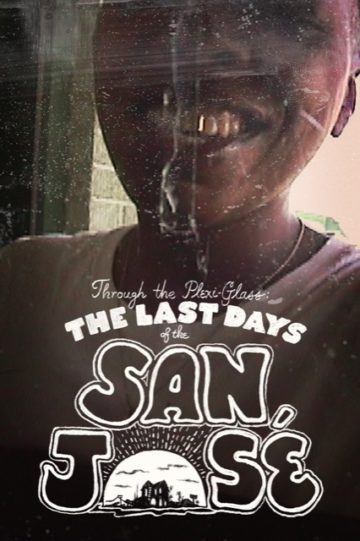
Lambert then weaves in clips of anonymous customers recorded through the titular plexi-glass at the front desk. When we spoke in March, she said she got releases from anyone she interviewed in depth, stopped recording when asked, and posted big signs alerting people that they were being filmed. But this approach suggests Lambert didn’t do anything to mitigate the power dynamic of an owner recording clients in difficult, often desperate, situations. She records someone as he struggles to explain that he doesn’t have a good ID to check in with; she enters one man’s room, records him while he’s sleeping, and then wakes him up on camera to tell him he’s missed checkout. In another montage, Lambert knocks on doors to tell residents how much money they owe for their rooms. When your landlord knocks on your door to tell you you’re behind on rent and waves a camera in your face, you might not feel comfortable saying “stop.”
So many oppressive systems are laid bare in this footage, but Lambert doesn’t seem to realize it. Her flippant use of clips of police interactions feels particularly tone-deaf today. “A year in, I totally welcomed the police,” she told me in our interview, citing the broken windows theory of policing, a controversial approach based on that idea that visible signs of disorder, like broken windows and vandalism, encourage crime, particularly in poor neighborhoods. “If you’re not taking care of a community, if things aren’t repaired, if windows are broken and there’s graffiti everywhere, people are more likely to disrespect that same place. The motel was like that,” she said.
We’re not encouraged to think critically about systemic problems in housing, policing, or drug addiction; this movie is about business. Mostly, we are supposed to care about how capital moves around. Banks kept denying Lambert’s loan applications because the hotel seemed like a bad investment. We’re meant to see the conditions of the motel as a source of consternation solely for Lambert, who’s frustrated that her business plan has been stalled. At every turn it is implied that her financial troubles are more important than anyone else’s, even the people who have so little money that basic shelter is precarious.
The slow violence of Lambert’s ideology does, however, make the film interesting—and unsettling—to watch. It’s an ideology that holds that the solution to the suffering of Black and poor people is to simply make them invisible and that the unequal, commerce-driven transformation of Austin is inevitable.
View this post on Instagram
Of course, Lambert didn’t invent this ideology, nor did she create the systems that perpetuate it. No one individual is responsible for the way Austin has changed so dramatically and so unequally. But Lambert lacks the imagination to see, or work toward, a model of change that’s any different, taking an active role in feeding unequal systems rather than interrupting them.
I asked Lambert if she thought much about race in the filming of the project, since many of the people she records are Black. Austin’s Black population has been in steady decline for more than two decades due to gentrification. “Sure, always,” she replied. “I think it’s also surprising how many people are white. I mean, there’s definitely some brown people in there, too.”
Lambert has been criticized for mishandling issues of race before: In 2018, her co-venture Lou’s Bodega sparked a small wave of local protest for building their brand around culturally appropriative Aztec imagery and the word “bodega,” in a rapidly gentrifying, historically Mexican American neighborhood. “I am sure I made mistakes… I take responsibility in whatever ways,” Lambert said in our interview. El Cosmico, the hotel Lambert operates in Marfa, offers glamping in tepees and draws randomly from Native American and Latin American cultures in its branding, and has contributed to gentrification in Marfa as well.
The film wants us to believe that Lambert has to build this hotel. There’s never a moment of self-awareness, a pause in which she considers how to help the people she’s filming as she builds her empire. It gives the impression she doesn’t really care, but perhaps, deep down, she does: The old San José, with all its symbolism of decay and devastation, haunts her enough that she made a film about it, a monument to the gentrifier’s guilt.
Read more from the Observer:
-
“Election Integrity” or Voter Intimidation?: Texas Republicans are pushing changes to election laws that would let partisan poll watchers record voters in polling places.
-
In San Antonio, Police Reformers Square Off with the Cops’ Union: A proposal to end collective bargaining, on the ballot May 1, aims to spur police accountability in Texas’ second-largest city.
-
Texans With Disabilities Were Left to Fend for Themselves During Winter Storm Uri: Emergency planning often overlooks the needs of the most vulnerable during natural disasters.
